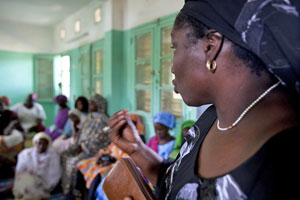Results and discussion: Urban/rural differentials in use of family planning services
 There are noteworthy differences between the CPR-improved countries and the CPR-stagnant countries in urban/rural CPR levels and trends (see appendix). Increases in modern contraceptive use among urban residents in CPR-improved countries are notable; however, it is the increase in contraceptive use in rural areas that is most impressive in these countries. Among the CPR-improved countries, all but Ethiopia had greater percentage point increases in contraceptive use in rural areas than in urban areas over the 10–15 year time span. In the CPR-stagnant countries, the increase in CPR was minimal at the national level during the time period, but more importantly, the small gains that did accrue resulted mainly from rural gains. Overall, very slight increases in urban use of contraception were experienced in the CPR-stagnant countries, with each of the five countries experiencing a decline in urban use of contraception over one of the observed time periods (between time 1 and time 2 or time 2 and time 3).
There are noteworthy differences between the CPR-improved countries and the CPR-stagnant countries in urban/rural CPR levels and trends (see appendix). Increases in modern contraceptive use among urban residents in CPR-improved countries are notable; however, it is the increase in contraceptive use in rural areas that is most impressive in these countries. Among the CPR-improved countries, all but Ethiopia had greater percentage point increases in contraceptive use in rural areas than in urban areas over the 10–15 year time span. In the CPR-stagnant countries, the increase in CPR was minimal at the national level during the time period, but more importantly, the small gains that did accrue resulted mainly from rural gains. Overall, very slight increases in urban use of contraception were experienced in the CPR-stagnant countries, with each of the five countries experiencing a decline in urban use of contraception over one of the observed time periods (between time 1 and time 2 or time 2 and time 3).
In order to fully understand the impact of these urban/rural differentials on the national value of CPR, it is also important to take into account each country’s degree of urbanization (see appendix). In a country that is predominantly rural, increasing access to family planning service providers in rural areas will have a greater impact on the national value of CPR than it would in a predominantly urban country, all else being equal (e.g., urban/rural demand for family planning). Overall, the percentage of the population that is urban is much higher in the CPR-stagnant countries than in the CPR-improved countries. Over 40% of the population is urban in four out of the five CPR-stagnant countries, whereas none of the CPR-improved countries has reached this level of urbanization. In fact, the percentage of population that is urban falls below 20% in Ethiopia, Malawi, and Rwanda.
- Health workforce determinants at play? Urban contraceptive use remains higher than rural contraceptive use in all five of the CPR-improved countries. However, given that these countries are predominantly rural, the magnitude of the gains in rural areas may indicate a growing ability to provide access to contraception in these underserved areas through a more equitable distribution of health workers and/or a redefinition of which cadres are legally able and trained to provide various family planning methods. On the other hand, observed declines in CPR in urban areas in the CPR-stagnant countries, which are relatively urban, may be an indication of national-level challenges in ensuring access to contraception, neglect of certain urban populations through unequal distribution of health workers, and/or an inability of the urban health workforce to keep pace with rapid rates of urbanization.

